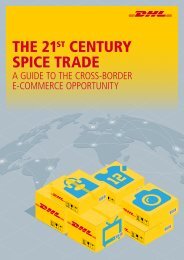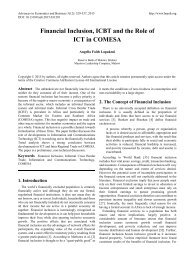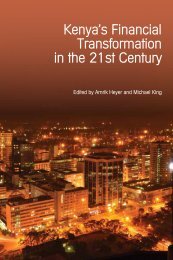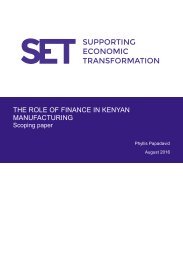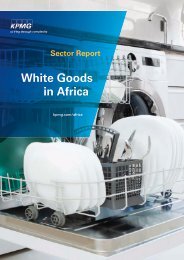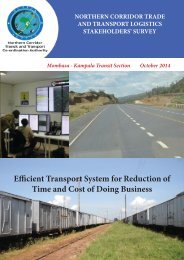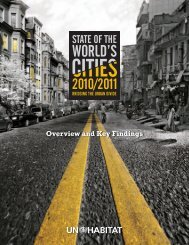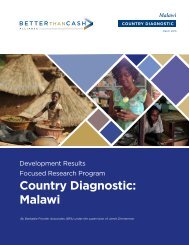FD
gvti301SEaf
gvti301SEaf
You also want an ePaper? Increase the reach of your titles
YUMPU automatically turns print PDFs into web optimized ePapers that Google loves.
AFRICA<br />
A new landscape<br />
The global financial crisis changed the landscape. Foreign<br />
banks scaled back their activities in some African countries,<br />
while new local banks increased their presence. The relative<br />
success of microfinance institutions in some countries (especially<br />
those that introduced a new technological platform<br />
to manage micro savings and deposit accounts) encouraged<br />
domestic banks to expand their networks. At the same time,<br />
nonbank financial institutions, such as savings and loans and<br />
cooperatives, formalized their activities. In response, regulators<br />
began introducing alternative models that helped cut<br />
intermediation costs. For example, agency banking allowed<br />
banks to locate nontraditional outlets in remote areas where<br />
brick-and-mortar branches and outlets are not financially<br />
feasible. Bank representatives at such outlets can perform<br />
authorized tasks, such as opening bank accounts, processing<br />
loan applications and loan repayments, and so forth.<br />
These changes were driven by demand. Market participants<br />
pressured regulators to build their capacity to cope with innovations<br />
and to develop institutions to support financial sector<br />
growth. Greater credit information sharing and the development<br />
of information for market participants, deposit insurance,<br />
and financial intelligence units generated a virtuous circle.<br />
But these changes pale compared with the transformation<br />
introduced by the emergence and low cost of digital<br />
financial services. In Kenya, mobile-phone-based technology<br />
(M-Pesa) for the delivery of financial services lowered<br />
transaction costs significantly and started a revolution in<br />
the payment system. M-Pesa is an electronic money transfer<br />
product that allows users to store value on their mobile<br />
phone or mobile account in the form of electronic currency.<br />
This currency can be used for a number of purposes, including<br />
transfers to other users, payments for goods and services,<br />
and conversion to and from cash.<br />
Suddenly, businesses did not have to give their employees<br />
time off to take money to their villages to care for relatives<br />
or small farms. Employees no longer had to travel long distances<br />
carrying cash and exposing themselves to robbery<br />
and other dangers. Relatives back home did not have to<br />
make long trips and risk assault or blackmail by local criminals<br />
who tracked the frequency of their travels. The digital<br />
revolution allowed people to make financial transactions<br />
and money transfers from the comfort of their homes. The<br />
lower cost left them with more disposable income, and they<br />
now had a secure way to store cash, even those working in<br />
Ndungu, 05/2/2016<br />
the informal economy.<br />
Immediate impact<br />
Traditional financial institutions were initially skeptical: it was<br />
hard to fathom how financial services, especially banking ser-<br />
Kenya: a four-step virtuous process<br />
Kenya still enjoys the advantages of an early start in pushing<br />
the frontier of financial inclusion through digital financial<br />
services. Geospatial surveys show how much financial<br />
institutions have responded to an increasingly welcoming<br />
environment (see chart). In Kenya a much larger share of the<br />
population is within 5 kilometers of a “financial access touch<br />
point” and had many more such touch points per person than<br />
was true in other countries in the region.<br />
Kenya stands out for its people’s use of mobile-phonebased<br />
money—in less than 10 years the share has grown<br />
from zero to more than 75 percent of the adult population.<br />
Banks have worked closely with telecommunications companies,<br />
which has allowed them a higher market presence<br />
there than in many emerging markets. In recent years, the<br />
insurance sector has expanded as well, targeting Kenya’s<br />
emerging middle class, and group-financing programs have<br />
also grown. This virtuous circle—facilitated by adaptive and<br />
flexible regulatory frameworks, reforms in financial infrastructure,<br />
and rapid improvements in skills and capacity—<br />
can be divided into four phases:<br />
Expansion of the mobile-phone technological platform for<br />
person-to-person transfers, payments, and settlements (products<br />
such as M-Pesa): In Kenya, the value of these transactions<br />
has reached the equivalent of 4.5 percent of annualized<br />
GDP a day.<br />
Introduction of virtual savings accounts using a digital<br />
financial services platform complemented by virtual banking<br />
services to manage micro accounts: in other words, digital<br />
financial services entered the core of banking intermediation.<br />
Exponential growth<br />
Banks have expanded their networks in urban and rural areas.<br />
(number of branches)<br />
1,600<br />
Rural branches (left scale)<br />
1,280<br />
Urban branches (left scale)<br />
ATMs (right scale)<br />
960<br />
640<br />
320<br />
0<br />
2005 07 09 2011 13<br />
Source: Central Bank of Kenya.<br />
(number of ATMs)<br />
3,000<br />
2,400<br />
1,800<br />
1,200<br />
Use of transaction, saving, and financial operations data<br />
from the digital financial services platform to generate credit<br />
scores and evaluate and price microcredit risk: This data<br />
analysis has helped overcome the so-called collateral technology<br />
hurdle, which has long been the main obstacle to financial<br />
access by the poor and has hindered the development of<br />
credit markets in Africa.<br />
Expansion of digital financial services for cross-border<br />
payments and international remittances: Regional crossborder<br />
payments and international remittance transfers are<br />
starting to come on board. The Kenyan example shows that<br />
once the process reaches this phase, demand for regulations<br />
to cope with innovations and more intensive use of technology<br />
to monitor this market can even discourage money laundering<br />
and the financing of terrorism.<br />
600<br />
0<br />
Finance & Development June 2016 15



